


A flour sack or flour bag is a bag or sack for flour. Large bulk bags as well as smaller consumer sizes are available.



A flour sack or flour bag is a bag or sack for flour. Large bulk bags as well as smaller consumer sizes are available.
A flour sack or flour bag is a bag or sack for flour. Sacks range in size and material.
Flour is often shipped from the miller to bakeries, institutions, and other bulk uses. Sizes range from 10 kg to 100 kg. One traditional construction was cheap cotton bags. These printed cotton bags were sometimes viewed as collectables; other times the flour sack fabric was repurposed into a variety of household items.
Current practices are to use multi-wall paper sacks. Some include a layer of plastic film for barrier properties and insect control. Woven polypropylene bags are also used for high strength; at least one variety (Purdue Improved Crop Storage bags) also includes inner plastic bags.
Consumer packages are often bags or sacks constructed of paper. Plastic films are also used, sometimes with reclosable features. Stand-up pouches of flour have recently been introduced. [1]
A wide variety of wheat flour are available. Flour can also be made from other grains, roots, nuts, etc. Packaging engineers and food scientists need to understand the properties of the particular flour, intended handling and logistics systems, and desired shelf life. [2] Package forms and materials can be matched to these needs. [3]

Insects can be a problem. When available, a suitable insecticide can be used; care must be used to ensure product safety. Hermetic plastic bags also help. [5] [6] When insect infestation is noted, one method of stopping further growth is to freeze the sacks of flour for several days. [7]


A tea bag or teabag is a small, porous, sealed bag or packet, typically containing tea leaves or the leaves of other herbs, which is immersed in water to steep and make an infusion. Originally used only for tea, they are now made with other tisanes as well.

Jute is a long, rough, shiny bast fiber that can be spun into coarse, strong threads. It is produced from flowering plants in the genus Corchorus, of the mallow family Malvaceae. The primary source of the fiber is Corchorus olitorius, but such fiber is considered inferior to that derived from Corchorus capsularis.
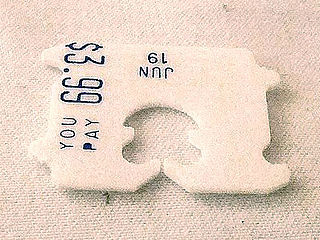
A bread clip is a device used to hold plastic bags closed, such as those in which sliced bread is commonly packaged. They are also commonly called bread tags, bread tabs, bread ties, bread buckles, or bread-bag clips. By sealing a bag more securely than tying or folding over its open end, and thus providing a nearly hermetic seal, the contents are preserved longer. In some cases, the color of the tag indicates the day on which it was baked, although there is no universal standard for the color code.

A gunny sack, also known as a gunny shoe, burlap sack, hessian sack or tow sack, is a large sack, traditionally made of burlap formed from jute, hemp, sisal, or other natural fibres, usually in the crude spun form of tow. Modern-day versions of these sacks are often made from synthetic fabrics such as polypropylene.

Plastic shopping bags, carrier bags, or plastic grocery bags are a type of plastic bag used as shopping bags and made from various kinds of plastic. In use by consumers worldwide since the 1960s, these bags are sometimes called single-use bags, referring to carrying items from a store to a home. However, it is rare for bags to be worn out after single use and in the past some retailers incentivised customers to reuse 'single use' bags by offering loyalty points to those doing so. Even after they are no longer used for shopping, reuse for storage or trash is common, and modern plastic shopping bags are increasingly recyclable or compostable. In recent decades, numerous countries have introduced legislation restricting the provision of plastic bags, in a bid to reduce littering and plastic pollution.
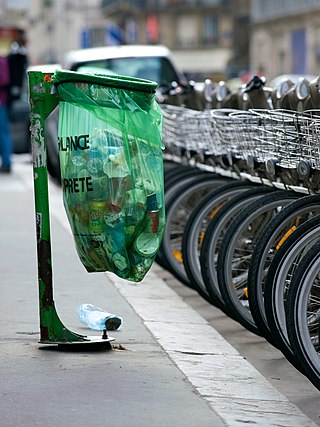
A plastic bag, poly bag, or pouch is a type of container made of thin, flexible, plastic film, nonwoven fabric, or plastic textile. Plastic bags are used for containing and transporting goods such as foods, produce, powders, ice, magazines, chemicals, and waste. It is a common form of packaging.

A bin bag, rubbish bag, garbage bag, bin liner, trash bag or refuse sack is a disposable bag used to contain solid waste. Many bags are useful to line the insides of waste containers to prevent the insides of the receptacle from becoming coated in waste material. Most bags today are made out of plastic, and are typically black, white, or green in color.

A paper bag is a bag made of paper, usually kraft paper. Paper bags can be made either with virgin or recycled fibres to meet customers' demands. Paper bags are commonly used as shopping carrier bags and for packaging of some consumer goods. They carry a wide range of products from groceries, glass bottles, clothing, books, toiletries, electronics and various other goods and can also function as means of transport in day-to-day activities.

A flexible intermediate bulk container (FIBC), jumbo, bulk bag, super sack, big bag, or tonne bag is an industrial container made of flexible fabric that is designed for storing and transporting dry, flowable products, such as sand, fertilizer, and granules of plastic.
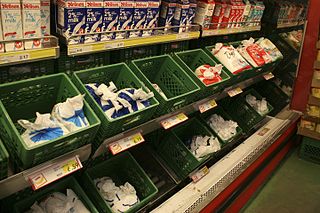
A milk bag is a plastic bag that contains milk. Usually one of the corners is cut off to allow for pouring, and the bag is stored in a pitcher or jug.
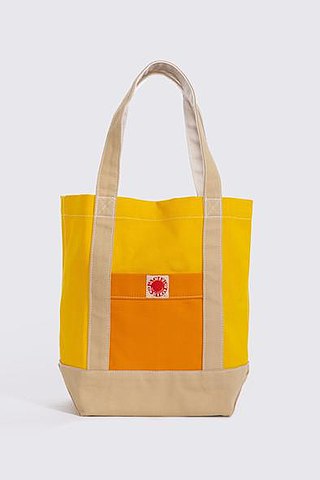
A tote bag is a large, typically unfastened bag with parallel handles that emerge from the sides of its pouch.

A reusable shopping bag, sometimes called a bag for life in the UK, is a type of shopping bag which can be reused many times, in contrast to single-use paper or plastic shopping bags. It is often a tote bag made from fabric such as canvas, natural fibres such as jute, woven synthetic fibers, or a thick plastic that is more durable than disposable plastic bags, allowing multiple use. Other shoppers may use a string bag or a wheeled trolley bag. They are often sold in supermarkets and apparel shops.
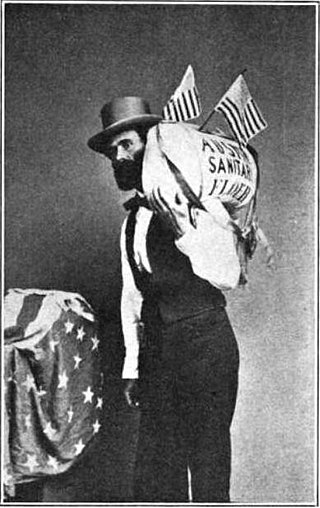
Reuel Colt Gridley was an American storekeeper who gained nationwide attention in 1864, when he repeatedly auctioned a plain sack of flour and raised over US$250,000 for the United States Sanitary Commission, which provided aid to wounded American Civil War soldiers.
A plastic bag ban or charge is a law that restricts the use of lightweight plastic bags at retail establishments. In the early 21st century, there has been a global trend towards the phase-out of lightweight plastic bags. Single-use plastic shopping bags, commonly made from low-density polyethylene (LDPE) plastic, have traditionally been given for free to customers by stores when purchasing goods: the bags have long been considered a convenient, cheap, and hygienic way of transporting items. Problems associated with plastic bags include use of non-renewable resources, difficulties during disposal, and environmental impacts. Concurrently with the reduction in lightweight plastic bags, shops have introduced reusable shopping bags.

A bag is a common tool in the form of a non-rigid container, typically made of cloth, leather, paper or plastic. The use of bags predates recorded history, with the earliest bags being lengths of animal skin, cotton, or woven plant fibers, folded up at the edges and secured in that shape with strings of the same material. Bags can be used to carry items such as personal belongings, groceries, and other objects. They comes in various shapes and sizes, often equipped with handles or straps for easier carrying.
Purdue Improved Crop Storage (PICS) bags are a hermetic storage technology developed by Purdue University. PICS bags are used to reduce post-harvest cowpea losses due to Bruchids infestations in West and Central Africa.
Pollination bags, sometimes called crossing bags, isolation bags or exclusion bags, are containers made of various different materials for the purpose of controlling pollination for plants.
Reusable packaging is manufactured of durable materials and is specifically designed for multiple trips and extended life. A reusable package or container is "designed for reuse without impairment of its protective function." The term returnable is sometimes used interchangeably but it can also include returning packages or components for other than reuse: recycling, disposal, incineration, etc. Typically, the materials used to make returnable packaging include steel, wood, polypropylene sheets or other plastic materials.
Grain storage on a subsistence farm is primarily based on minimizing grain loss. In modern agricultural practices there are methods of managing under 1% grain loss, but small subsistence farms can see 20% - 100% of grain loss. This causes starvation and an unstable food supply. Grain loss can be caused by mold growth, bugs, birds, or any other contamination.
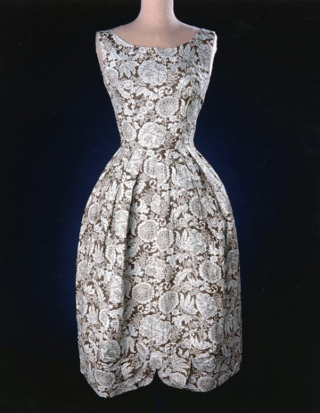
Feed sack dresses, flour sack dresses, or feedsack dresses were a common article of clothing in rural US and Canadian communities from the late 19th century through the mid 20th century. They were made at home, usually by women, using the cotton sacks in which flour, sugar, animal feed, seeds, and other commodities were packaged, shipped, and sold. They became an iconic part of rural life from the 1920s through the Great Depression, World War II, and post-World War II years.